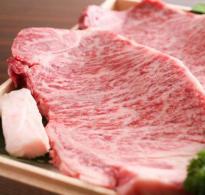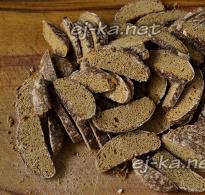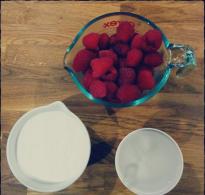Royal gooseberry jam. Royal gooseberry jam: detailed recipes with photos
Gooseberries look like a fairly ordinary berry; some people even find them quite sour or hard, while others consider them not suitable for them at all. The most interesting thing is that this seemingly inconspicuous and dull berry has the name “Tsarskaya”. Yes, that’s what this berry is popularly called, and all because the jam made from gooseberries after preparation and boiling actually turns out royal. For example, at one time, Catherine the Great, after tasting such jam, was delighted and amazed at its taste and immediately dubbed it “royal”, after which she even awarded her cook a precious ring for this wonderful treat.
Recipes for making jam.
It so happened that to this day there are recipes for making gooseberry jam (“ emerald jam from gooseberries”) have been preserved and, moreover, are used by us very often.
In order to prepare this jam, it is necessary to skillfully and carefully prepare the gooseberries themselves and do this as skillfully as our ancestors did, namely, select the unripe berries for jam and marinades, and the ripe ones for excellent wine. The selected berries should be washed thoroughly and the remaining stalks should be removed; this should be done with a sharp knife, making a side cut, and you can also use a hairpin or a small spoon, all this will allow you to remove the seeds along with the pulp. Next, five full glasses that are filled with berries should be filled with a decoction of cherry leaves in a cold state. To do this, you need to take a couple of leaves in your hand and two or three glasses clean water and bring it all to the boiling point, and then simply cool it by putting the prepared mixture in the refrigerator overnight. In the morning, the broth should be drained and cooked with this broth. sugar syrup for two three glasses of broth, seven glasses of sugar.
Next, you need to boil the gooseberry syrup for five minutes and put the previously prepared berries into it. After the syrup boils again, you need to reduce the heat on the gas and cook it for about fifteen minutes, while strictly removing the film that forms. When the jam is cooked, you need to cool it immediately by placing it in a basin or other container with cold water, this is done so that the jam does not change its color, which should be emerald green or yellow-green. After cooking, it must be stored in the refrigerator, because under other conditions it will spoil very quickly.
We also need to emphasize one of the recipes for making gooseberry jam, namely the recipe from the family of the well-known A.S. Pushkin.
We take seeds clean and rinsed in water, unripe and green gooseberry, puts it in a pot, and it is necessary to arrange the resulting rows with rows of cherry and sorrel leaves. Next, pour in Russian vodka and close the lid coated with dough for a while, then put the pot in the oven for a couple of hours, but in such a heated and hot oven, which happens after cooking bread in them.
The next day, throw away the gooseberries and pour in cold water with pieces of ice, stir after an hour, and repeat this up to three times, and then return the berries to cold water with pieces of ice and mix it too, keeping the berries in it for four hours at a time. After completing this cycle, you need to throw the berries on a sieve, and then put them on a linen tablecloth, where the gooseberries can easily dry. You need to select as many dried berries as necessary to maintain the proportion of one kilogram of berries to two kilograms of sugar plus a glass of water.
Next, you need to boil the syrup from three to four parts of sugar and boil, then skim off the foam. Pour gooseberries into the resulting syrup and bring everything to the boiling point, and when it boils, add the remaining sugar, and then hold for low heat, not forgotten to taste. The resulting jam is best placed in pre-prepared jars, which, after the jam is finally poured into them, should be wrapped in paper with wax, and tied with a bubble on top and the whole thing tied.
Royal gooseberry jam (royal jam).
As an option and for variety, we can offer you another antique and one of popular recipes, dedicated to the preparation of “royal” jam from gooseberries. At the same time, you will get no less amazing, beautiful and fragrant jam, compared to the recipes above.
This will require an equally large investment of patience, time and effort, but the final product will please you very much and your suffering will be very quickly forgotten and will pay off, because simply green berries of a delicate color in jam and in amber syrup this is nothing more than a real pride for any housewife and, on top of that, it’s a delicious delicacy.
Method for preparing royal gooseberry jam according to an old recipe:
1) It is necessary to select tight and dense gooseberries, and they should be of medium size;
2) Rinse the collected berries in slightly lukewarm water, but be careful of the ends of the berries on both sides;
3) Using the end of a sharpened knife, you need to cut each gooseberry, removing all its seeds (you can also use a scalpel for these purposes). If necessary, the berries can be washed again;
4) Select fresh leaves cherries without any damage and wash them under running warm water;
5) Choose a suitable container for making jam and gradually add berries there, combining them with cherry leaves;
6) Boil water and pour it into the vessels (jars) and leave it all for six hours. When the resulting mixture has cooled, you need to cover the dishes with paper.
7) After the allotted time has passed, pour sugar into a bowl and pour the liquid from the bowl with the gooseberries into it, then heat until the sugar dissolves.
9) Carefully pour the berries without leaves into the syrup and move around. Carry out the cooking process for ten minutes, and then add the missing cherry leaves.
10) Cook for another three to five minutes until the berries become transparent.
11) When the jam is ready, it must be placed in cool place. Low air temperature contributes to the transparency of the jam syrup.
In mid-summer you can buy gooseberries at the market. Mostly they take it to eat delicious berry, but gooseberries make very delicious jam. Its name is “Royal” and in addition to gooseberries, it uses other, quite available ingredients. Let’s say right away that the technology for making this jam is quite complicated, but it’s worth making a couple of jars.
What products are needed for royal gooseberry jam?
- Ripe, but not very soft gooseberries, large in size and green in color - 5 cups.
- Core walnut– 100 g.
- Fresh cherry leaves – 50 pcs.
- Granulated sugar – 7 glasses.
- Water – 7 glasses.
In addition to the ingredients, also prepare a saucepan for cooking syrup, a bowl for cooking jam, and a wooden spoon for stirring the jam. You will also need a thin, sharp knife and the smallest coffee spoon.
How to properly cook royal gooseberry jam
Precise technology for making jam:
- Wash under running water cherry leaves and put them in a saucepan. Fill the leaves with all the water and place the dishes on low heat. Boil the leaves in water for 15 minutes and then set this decoction aside to cool. After two hours, strain the broth through a sieve and take only one and a half glasses of this aromatic water. Discard the leaves, reserving about five for later use.
- Pour sugar into a copper basin for making jam and fill it with a decoction of leaves. Stir the sugar until it is almost completely dissolved, and then place the bowl on the stove. Cook the syrup until the sugar is completely dissolved; if foam forms on the surface during the cooking process, be sure to remove it.
- Cut off the stems and sepals of clean gooseberries. Using a thin knife, make a small cut on each berry, which should be placed along the long side, i.e. along. Through this cut, remove the pulp with seeds. You can use them for any other dishes, such as jelly.
- Chop the walnut kernels to such a size that the piece fits completely inside the seeded gooseberries.
- Stuff each berry with a piece of nut.
- Dip gooseberries stuffed with nuts into the prepared hot syrup. Also put five pieces of cherry leaves that remained after cooking there.
- Place the bowl of gooseberries in syrup on the stove and bring the contents to a boil over very low heat. Brew royal jam only 15 minutes. Watch the fire - if it is too high, pieces of nuts may fall out of the gooseberries when boiling vigorously.
- Place the hot jam along with cherry leaves into sterilized jars and quickly roll up the hot lids. Let the jam in the jars cool completely, and only then transfer the jam to the cold.
This gooseberry jam is very flavorful due to the fact that the syrup is cooked on cherry leaves. They also give the jam an unusual emerald color. Well unusual taste The jam comes mainly from the walnuts found inside each berry. If desired, instead of walnuts, you can take hazelnuts or even cashews - this will be a completely different royal delicacy.
Gooseberries are a wonderful berry for winter preparations, both sweet and savory. Among sweet preparations, royal gooseberry jam is especially famous. This tasty and impressive jam is also called emerald jam.
Of course, it is much easier to make jam, jelly or jam from gooseberries, which taste almost as good. But royal jam has not only great taste, but also exquisite in appearance. Therefore, the berries for it should be prepared carefully, carefully cutting off the tails and dry parts of the flowers with scissors.
Ingredients:
- gooseberries – 1 kg
- sugar – 1 kg
- cherry leaves leaves – 100 g
- citric acid – 1 teaspoon
- vanilla sugar– 1 sachet
- vodka – 50-60 ml
Preparation:
- Wash the gooseberries thoroughly and cut off the ends. Carefully cut the side of each berry and remove the seeds with a wire loop or paperclip. Place the gooseberries processed in this way into a large bowl, pour ice water and place in the refrigerator for about 6 hours. Then drain the water, placing the berries in a colander.
- Wash the cherry leaves, place in a saucepan, pour in water (5 cups), add citric acid and bring to a boil over medium heat. Then reduce the heat, let it simmer for 5 minutes and strain the broth.
- Pour sugar into the cherry broth, return the pan to the heat and, stirring until the sugar dissolves, bring the syrup to a boil. Add vanilla sugar, vodka and stir until sugar dissolves.
- Pour the boiled syrup over the gooseberries and let them brew for about 15 minutes.
- Bring the berries in the syrup to a boil and cook for 10 minutes over low heat. Place the hot royal jam into dry sterile jars and seal tightly.
Another second - and you, having torn through the dacha thickets and scratched your hands on the thorns, get to the coveted berries. And when you bite through the thick skin of a gooseberry and the juicy inside with small seeds falls into your mouth, you involuntarily squint your eyes with pleasure - just as many great people did long before you: Catherine the Second, Henry VIII, Anton Chekhov.
To Moscow via America
Gooseberries were born in the south of Europe: ancient Roman historians were the first to write about them. In Kievan Rus, gooseberries have been known since the 11th century - the earliest mentions of “northern grapes” found in monastic chronicles date back to this period. Only the gooseberry was called differently then - somewhere agryz, somewhere agrus, and from the 15th century - bersenem. So the name of Bersenyevskaya embankment in the center of Moscow can be translated as “gooseberry”: in ancient times, the royal gardens were located there and the royal gardeners lived there. Later the name “kryzh” appeared, followed by “gooseberry”. Large areas were allocated for planting, and the harvest was such that there was enough for anything and everything. From gooseberries they made preserves, jams, jelly, made wines that were in no way inferior in taste and aroma to grape ones, made sauces for fish and meat dishes. Its berries were pickled and served as a delicious appetizer.
Western Europe appreciated gooseberries in the 13th century: subjects of the English king Henry VIII bred a variety with berries the size of plums. The British came up with an unusual name - gooseberry, “goose berry”, since gooseberries are used in the sauce that is served with roast goose.
Finally, the nickname " royal berry»gooseberries were introduced into Rus' during the reign of Catherine II: the empress adored jam made according to special recipe. The inventor of the recipe below was a cook who received a ring with an impressive emerald as a royalty:
Select not quite ripe gooseberry greenish in color, rinse, remove stems, dry calyxes, flowers and seeds, cut, carefully squeeze out the seeds, fill the berries with pieces walnuts, pour in a decoction of cherry leaves so that it covers the berries, and place in a cool place for a day. To prepare the decoction you will need two handfuls of green cherry leaves and five glasses of water. Wash down the leaves with water, put on fire and boil for 3-5 minutes (make sure that the broth does not turn red), then strain. On the second day, remove the berries from the broth in which they were infused and prepare sugar syrup (at the rate of 1.4 kg of sugar per 8 cups of peeled gooseberries). Dip the berries into boiling syrup and cook until tender, about 15 minutes, periodically skimming off the foam. In the end it will work out clear jam emerald color.
At the beginning of the 19th century, gooseberries were attacked by powdery mildew, a disease that to this day plagues varieties that are not resistant to it. Shrubs brought from America were to blame for this. Over the course of several years, the disease practically wiped out mass plantings of gooseberries. However, later, disease-resistant species were brought from the same America, and a group of hybrid varieties was born. In short, modern gooseberries, grown throughout the Western Hemisphere, are the love child of two continents.
Let's take it apart piece by piece
Gooseberries contain biologically active compounds - anthocyanins and flavans, which are involved in photosynthesis, preventing harmful effects ultraviolet sunlight. Together with ascorbic acid, these substances contribute to the development of immunity. Succinic acid and serotonin make gooseberries harmless, for example, in comparison with coffee, a stimulant of physical and mental activity. In addition, serotonin has antitumor properties. After the accident at the Chernobyl nuclear power plant, many victims began to consume sea buckthorn, not knowing that gooseberries also have the ability to remove radionuclides and heavy metals from the body.
One hundred grams of gooseberries contain up to 85 g of water, 0.7 g of proteins, 9.9 g of carbohydrates, 2.0 g dietary fiber, 1.9 g free organic acids; from vitamins – 260 mg of potassium, 28 mg of phosphorus, 22 mg of calcium, 1.6 mg of iron, 0.20 mg of provitamin A, 0.060 mg of vitamin PP, 30 mg of vitamin C, vitamins B1 and B2, folic acid. Almost 90 percent of the digestible sugars in gooseberries are glucose and fructose.
Gooseberries are especially useful for anemia, skin rashes, frequent hemorrhages (mixed with honey), for healing the intestines, and stimulating bile secretion. The juice is consumed as a refresher; it has a very beneficial effect on metabolism. It has a mild laxative, diuretic and choleretic effect, so it is recommended for people suffering from kidney disease, bladder and liver. Gooseberries are useful for heart disease, hypertension, atherosclerosis, obesity and anemia, as a preventive measure for the appearance of tumors. Decoctions, syrups, and gooseberry compotes will be useful for those recovering from serious illnesses. However, people suffering from enteritis or peptic ulcer in the acute stage, you should limit the consumption of gooseberries or completely exclude them from the diet due to large quantity fiber and organic acids. In addition, it is contraindicated in diabetic patients due to high content sugars
PICKLED GOOSEBERRY
Berries – 1 kg, water – 1 l, salt – 15 g, sugar – 200 g, apple cider vinegar– 100 g.
Collect the berries before the seeds ripen. Prick with a fork to prevent them from bursting. Place tightly in jars and fill with boiling solution, place in boiling water for 15 minutes, cover with a lid. Then roll up the lids. In this form, the berries are stored for two to three years at room temperature. Serve pickled gooseberries with meat, poultry, and fish.
GOOSEBERRY MOUSSE
Gooseberries – 200 g, water – 0.5 l, sugar – 50 g, semolina – 1 tbsp. spoon.
Pour boiling water over the gooseberries and cook for five minutes. Then rub through a sieve, put on fire, add sugar, semolina and cook for another 10 minutes. Cool the resulting mass and beat until a fluffy foam forms. Serve chilled.
GOOSEBERRY SAUCES
1. Gooseberries (unripe) – 500 g, fresh garlic – 200 g, dill (greens) – 100 g.
Pass the gooseberries together with peeled garlic through a meat grinder. Then add finely chopped dill, salt, mix everything well and place in small jars. Keep refrigerated.
2. Gooseberries (ripe) – 500 g, walnut or hazelnut kernels – 100 g, basil or any other greens – 100 g, garlic – 50 g.
Gooseberries, nuts, garlic through a meat grinder, add finely chopped herbs, salt. Mix everything thoroughly and place in glass jars. Keep refrigerated.
Delicious gooseberry jam demands special attention. Patient housewives can handle anything, right? Let's prepare royal jam for tea and surprise guests with its brightness and unusual taste.
The royal gooseberry jam from green berries. Seeds are not allowed in jam, and if you remove them from ripe berries, then only one peel will remain. There is an option when royal jam is prepared with nuts inside each “gooseberry,” but I decided not to scare novice cooks with the composition and prepared almost a classic.
So, the recipe for royal gooseberry jam. You will need products from the list.
Cherry “brooms” are cut to the third leaf, filled with water from citric acid and insist.

Then bring to a boil, boil and cool.

The cherry water is poured into a bowl. Sugar, vanilla sugar and vodka are added to it. The syrup is brought to dissolution and then to a boil.

At this time, the collected gooseberries are washed with water. It cleans well of tails and seeds. A split incision is made with a knife, and the seeds are picked out with a nail or a pin.

Gooseberries are poured with hot syrup until the berries are covered and soaked for 2 hours.

Then quickly boil for 10 minutes. The resulting semi-liquid jam is poured into sterile containers. The rest of the royal jam is served with tea for testing. When the gooseberry jam is well infused, the berries will wrinkle and the consistency of the jam will become thicker. The color of royal gooseberry jam varies from delicate yellow-green to yellow with red.







